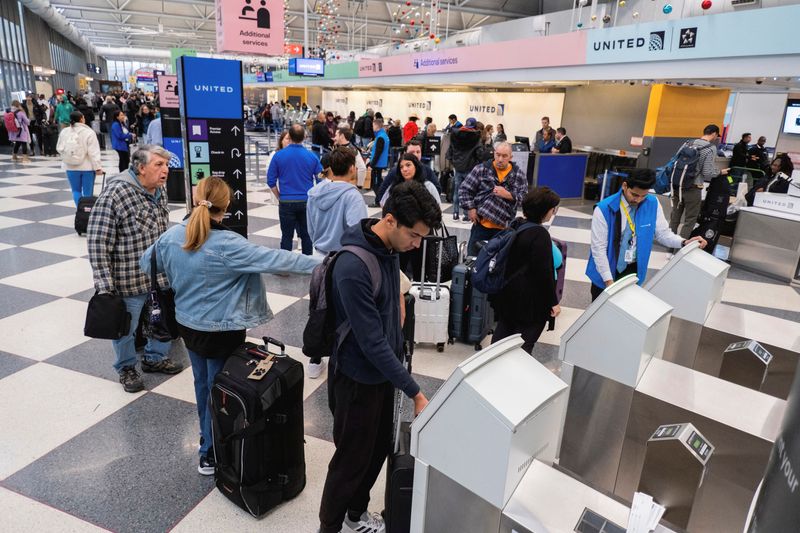By Lucia Mutikani
WASHINGTON (Reuters) – U.S. producer prices picked up in October, lifted by higher costs for services like portfolio management and airline fares, another sign that progress towards lower inflation was stalling.
The report from the Labor Department on Thursday followed on the heels of news on Wednesday that consumer inflation had barely budged last month, leaving economists to expect firmer readings in the personal consumption expenditures price indexes in October. The U.S. central bank tracks the PCE price measures for its 2% inflation target.
Combined with a drop in first-time applications for unemployment benefits to a six-month low last week, which suggested the abrupt slowdown in job growth in October was an aberration, and tariffs on imported goods expected to be unveiled by President-elect Donald Trump’s incoming administration, economists said the Fed was likely to opt for fewer rate cuts in 2025 than the four it projected in September.
Indeed, Fed Chair Jerome Powell said on Thursday that if economic data allows a slower pace of rate cuts, then that would be the “smart thing to do.” Some economists now see a rate cut at the U.S. central bank’s Dec. 17-18 meeting as a very close call.
“We still expect the Fed to cut rates by 25 basis points in December, but the risk appears to be tilting towards a shallower cutting cycle given resilient activity and stubborn inflation,” said Stephen Juneau, a U.S. economist at Bank of America Securities.
The producer price index for final demand rose 0.2% last month after an upwardly revised 0.1% gain in September, the Labor Department’s Bureau of Labor Statistics said. The increase in the PPI was in line with economists’ expectations. The PPI was previously reported to have been unchanged in September.
In the 12 months through October, the PPI increased 2.4% after advancing 1.9% in September.
Services prices rose 0.3% after gaining 0.2% in September. A 3.6% surge in portfolio management fees amid a stock market rally accounted for more than a third of the rise in services costs. Airline fares jumped 3.2% after rising 1.1% in the prior month. Hotel and motel room prices fell 0.5%.
The cost of hospital outpatient care rose 0.6%. But hospital inpatient care prices fell 0.4%. Overall healthcare costs increased 0.5%, the most since January.
There were also gains in the prices of vehicle wholesaling, computer hardware, software and supplies retailing as well as cable and satellite subscriber services.
The government introduced prices for new-model-year passenger cars and light motor trucks with the October PPI report. Passenger car prices rose 0.3% while light motor vehicle prices were unchanged.
Food prices dropped 0.2%, with the cost of eggs plummeting 22.0%. Gasoline prices decreased 0.9%. Wholesale goods prices rebounded 0.1% after falling 0.2% in September.
Portfolio management fees, healthcare, hotel and motel accommodation and airline fares are among the components that go into the calculation of the PCE price index, excluding the volatile food and energy components.
The government reported on Wednesday that consumer prices increased 0.2% in October for the fourth straight month, while a measure of underlying inflation gained 0.3% for the third consecutive month.
Following the release of the PPI data, economists raised their estimates for the October core PCE price index increase to a 0.28%-0.32% range. That was up from the 0.2%-0.26% band after the CPI data. Core inflation gained 0.3% in September.
It was forecast to rise 2.8% on a year-on-year basis in October after increasing 2.7% in each of the prior three months. Core inflation was projected to advance at a 2.9% annualized rate in the three months to October from a 2.3% pace in September.
Stocks on Wall Street ended lower. The dollar gained against a basket of currencies. Yields on shorter-dated U.S. Treasuries rose.
JOBLESS CLAIMS FALL
Following Powell’s comments, financial markets lowered the odds of a 25-basis-point rate cut next month to 62.4% from 79.1% earlier, according to CME Group’s (NASDAQ:) FedWatch Tool. The odds of rates being unchanged rose to 37.6% from 20.9%.
“The continued normalization of the economy and move toward better balance in the labor market will return core PCE inflation to a gradual downward trajectory over coming quarters, although the potential for sizable tariff increases places some upside risk into that outlook next year,” said Michael Hanson, an economist at J.P. Morgan.
Policymakers are keeping a wary eye on the labor market, which has shown signs of significant softening amid tepid hiring. But the latest weekly jobless claims data suggested the labor market had continued to chug along in early November.
Initial claims for state unemployment benefits dropped 4,000 to a seasonally adjusted 217,000 for the week ended Nov. 9, the Labor Department said in another report.
Claims surged in early October amid distortions from Hurricanes Helene and Milton as well as a strike by factory workers at Boeing (NYSE:), but layoffs have remained historically low, which is underpinning the economy.
The Fed last week cut its benchmark overnight interest rate by 25 basis points to the 4.50%-4.75% range.
The central bank initiated its policy easing cycle with an unusually large half-percentage-point rate cut in September, its first reduction in borrowing costs since 2020. It hiked rates by 525 basis points in 2022 and 2023 to tame inflation.

The number of people receiving benefits after an initial week of aid, a proxy for hiring, fell 11,000 to a seasonally adjusted 1.873 million during the week ending Nov. 2, the claims report showed. The decline in the so-called continuing claims mostly reflected the waning disruptions from the hurricanes.
“There is no sign of a sustained pickup in layoffs,” said Stephen Stanley, chief U.S. economist at Santander (BME:) U.S. Capital Markets.







